Pachino – The Invasion of Sicily Continues
In the last post I described the events leading up to the successful landing at Bark West Beach by 26,000 Canadian troops as part of Operation Husky, the Allied invasion of Sicily. I am part of a group of thirty-five Canadians who have come to Sicily with Liberation Tours, a company that specializes in Canadian military tours. After reboarding our bus at Bark West we drove back down the narrow lanes in the southernmost part of Sicily to the small town of Pachino, which was the first place in the entire Axis to be liberated. There was an important airfield just outside Pachino that had been deserted and ploughed up by the time the Canadians arrived. The town of Pachino was then entered, specifically the Royal Canadian Regiment (RCRs) and the Hastings and Prince Edward Regiment (the Hasty Ps). Before our current contingent of Canadians enters Pachino, a word about current events in Italy at the time of Operation Husky.
The Situation in Italy during Operation Husky
Benito Mussolini and the Partito Nazionale Fascista, aka the Fascists, had been in power for over twenty years. Mussolini was always more popular in Italy than Hitler was in Germany, receiving up to 1,500 letters a week from devoted admirers (compared to Hitler’s 1,000 a month). However, the Fascist party was not universally admired and Sicily was one place where hardline fascists were not so common. By the time the Allies landed in Sicily the Italian armed forces had sustained huge losses in the North Africa campaign with over 22,000 killed and another 250,000-350,000 captured. I always tended to think of the North Africa campaign as a battle between the British under Montgomery and the Germans under the Desert Fox, Irwin Rommel, but the reality is that the Italians had more men in action and had higher casualties than the Germans. For many Italians, including the ones doing the fighting, it seemed inevitable that the war was lost. I am sure many young soldiers thought, “Why die a useless death for a lost cause?”.
Two weeks after Operation Husky began, Mussolini was voted out of office by his own party, who then had him arrested. The new government was anxious to conclude a peace that would see Italy spared the ravages of an all out invasion. I think this dynamic that was playing out not only in Rome, but in the minds of ordinary Italians, goes a long way to explaining why the some of the Italian forces in Sicily put up not much more than token resistance when confronted by Allied forces during the first two weeks of Operation Husky. To be sure some Italian units fought bravely, particularly in some of the American sectors, (almost 4,700 were killed and over 35,000 wounded), but the overall pattern was one of surrender rather than fighting. All told over 152,000 Italians became POWs or went awol during Operation Husky as compared to just over 10,000 Germans captured. For the Canadians in those first heady days of the invasion it must have seemed like a relative cakewalk compared to what they had been told to expect, but that was not to last. Now let’s return to modern day Pachino where our tour co-ordinator John Cannon has told us that a surprise is in store.
Pachino
Even though Pachino is a small town, no less than two members of our group, one being Phil Craig from rural Ontario, tell the rest of us that their respective barbers back in Canada, hail from this place. Talk about a small world. We park the bus and get out for a leisurely walk up the side streets to exactly where we’re not sure. That’s the surprise. As we near a fairly large building I start to hear the strains of what sounds like O Canada! As we round the corner of what I now recognize is a school, we are greeted by this sight.
I have to admit that this gave me a lump in my throat and made me realize that even though we were technically enemies when we invaded Sicily in 1943, in reality, we were treated as liberators.
After everyone got settled, a small group of the school kids gathered on a platform and played the Italian anthem on their recorders and then the Canadian anthem was played again.
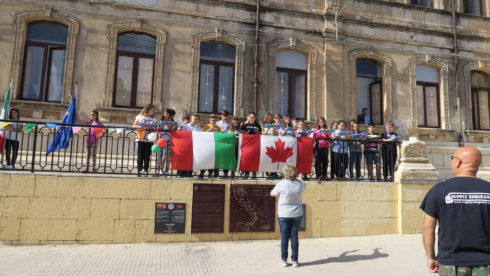
This was followed by a briefing on Pachino by tour historian Mark Zuehlke and then by the laying of a wreath by one of our members whose father was in Pachino over 73 years ago.
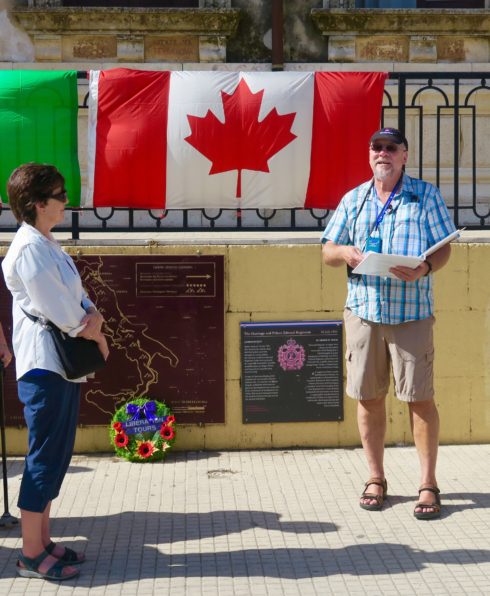
In the picture you can see several memorial plaques that all relate to the Canadian efforts to free Sicily.
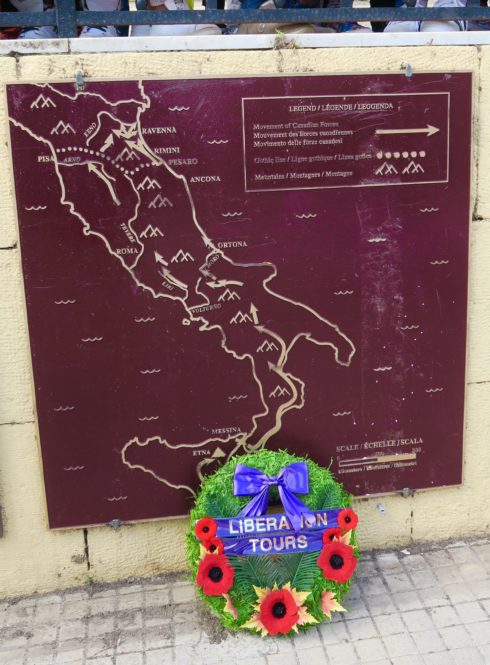
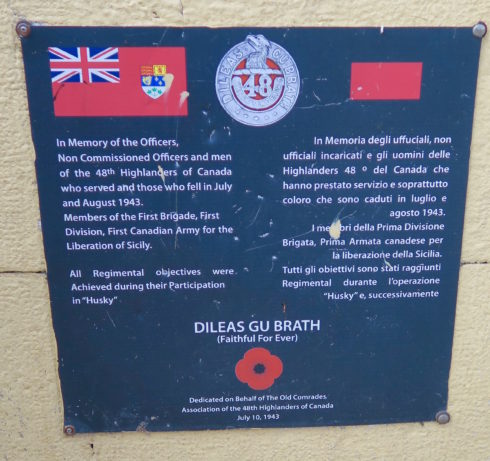
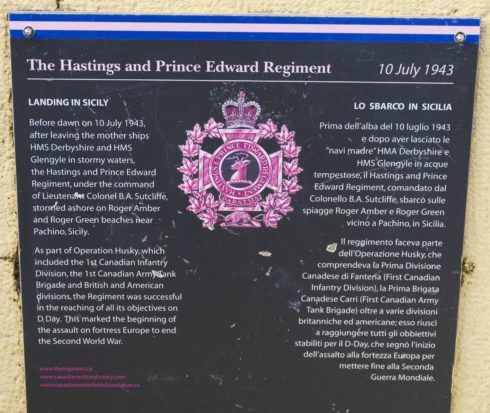
Note that the Hasty Ps were led ashore by Lt. Colonel B.A.Sutcliffe. It’s a name we will come across again.
We spent the next half an hour basically meeting and greeting with the children, their teachers and several elderly locals who, through the teacher’s translation, described their recollections as children, of the Canadians arrival in Pachino. Our tour co-ordinator, John Cannon, who had pre-arranged this surprise greeting with Rosalba ‘Rosie’ Scifoon on the Pachino side, is over six foot six and a giant by Sicilian standards. The children all wanted to get their picture taken with ‘Big Giovanni’. I commented to him that he could be mayor of Pachino if he wanted to be and for the rest of the trip he was ‘Big Giovanni, mayor of Pachino’.
We gathered on both sides of the memorial plaques for a group photo and then it was back to the bus, not without a few tears of joy and remembrance.
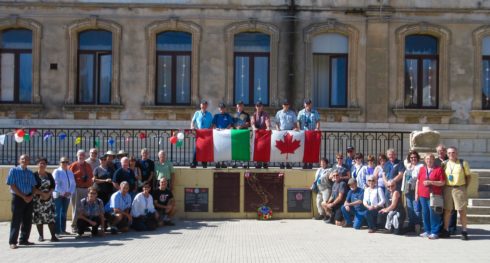
One of the traditions of Liberation Tours is to find specifically non-touristy places to stop for a communal lunch which is always included in the price of the tour. This is a refreshing change from the horrible spots that many traditional bus tours stop at. We had our first such lunch today at Valle Verde, not far from our final stop of the day at Grammichele. This was a very typical rural Sicilian restaurant with good food and excellent local wines, which are also always included gratis. This is their antipasto which preceded a pasta course and a meat course and then a great dessert. You are always more than sated and satisfied with the places that the guys at Liberation Tours have chosen.
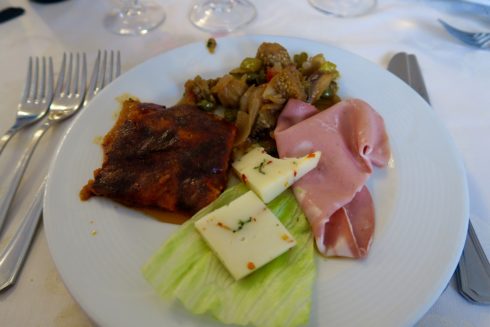
So far things had been going pretty well for the Canadian forces in Italy, but that was about to change. Have a look at this map and I’ll explain why. The areas in white are low lying coastal plains while the areas in brown or tan represent higher elevations, including some real mountains. Notice the striped red line on the right representing the British forces. They are almost all confined to the flatter areas, but even so they managed to get themselves bogged down trying to drive up the coast to Messina. The Canadians are to their left and you’ll notice that not far out from Pachino our route enters much more elevated and rugged territory. Our job was to outflank the British and help get them unstuck. All we had to do was take a few fortified hill towns along the way. Yeah, sure.
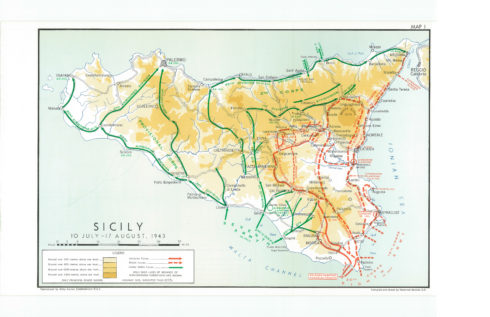
In the post on Operation Husky I described how three of the ships carrying our supplies and men had been torpedoed on the way to Sicily. Well by now the Canadians were really starting to realize how important that materiel was. Soldiers who were supposed to be driven inland, now had to walk. Mules and donkeys were commandeered or purchased as the case may be, but they were of limited help. Oh, and did I mention that in July and August the temperatures often exceeded 100°F (38°C)? And we all know about the fact that Italian water, if you could find any in this parched environment, was not safe to drink, but if you’re dying of thirst … So dysentery was rampant. And so were malarial mosquitoes. Quite the environment for Canadian boys from farms on the prairies, Ontario and Quebec, factories in the cities, lumber camps in B.C. and the Maritimes or mines in the north, to be getting their first taste of combat. It wasn’t just to be a baptism of fire, but heat, thirst, pestilence and exhaustion.
And there was one more little problem. The Germans had showed up – no more Mr. Nice Guy from the Axis forces.
Grammichele
The mountain town of Grammichele (pronounced Grammachelly) was the first place that Canadians faced troops from the well equipped Hermann Göring Panzer Division which possessed the dreaded Tiger tank. I say dreaded because, in all the war movies made in the 50’s and 60’s, this machine was the ultimate hobgoblin. The Allied troops would be making progress until the soundtrack would start playing ominous music and then this giant behemoth of a tank would round a corner and wreak havoc, until someone like Audie Murphy would inevitably take it out single handedly with a bazooka or well placed grenade. If only it were that easy. This is what you would be facing.
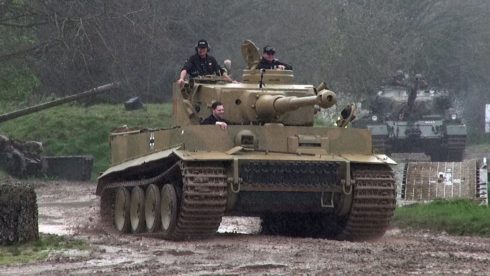
In the mountainous part of Sicily you won’t find the towns in the valleys, but more often than not, on the top of the hill for reasons dictated by history. Once you’ve been invaded by the Phoenicians, Greeks, Carthaginians, Romans, Byzantines, Goths, Vandals, Moors, Turks and a few others I probably missed, you learn that the safest place to be is high on a hill, preferably behind a fortified wall. And that’s where the Germans are in Grammichele, which sits 250 feet above the valley.
Today we are able to enter Grammichele without a problem, but due to its very narrow streets, have to park the bus and walk to the unique city centre. It is a hexagonal square with six entrances all equidistant apart and is unlike any town centre I have seen anywhere. This is what it looks like from above.
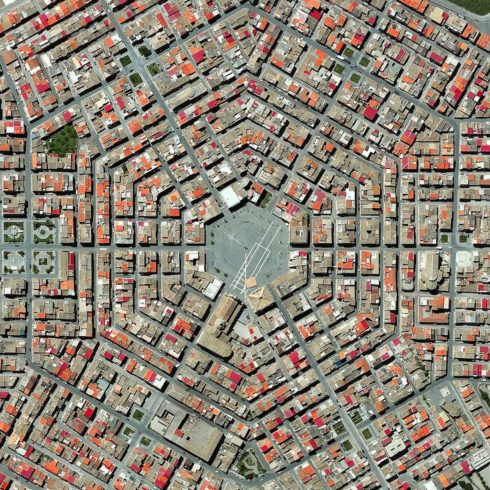
The Germans had seen the Canadians coming from miles away and decided to set a trap by having their tanks and light artillery vehicles lie in wait at a number of the entrances to the town centre. The idea was that the Canadians would drive their Sherman tanks into the town centre and then the Germans would open up from the places of concealment and ‘Zee Canadians vil be toast!’ Fortunately it didn’t work out that way as a trigger happy German opened fire too early, giving the game away. The Canadians, after losing one tank and several other vehicles, reacted quickly. If we couldn’t get our bus into these narrow streets, then the Germans sure as hell couldn’t turn their tanks around. The Three Rivers tank regiment, along with infantry support from the Hasty Ps, fought well that day, destroying three German tanks and other vehicles. The Germans beat a retreat and Grammichele was in Canadian hands by noon. It was our first Battle Honour in Sicily and was not without a cost. – 25 casualties including 7 dead.
Standing in Grammichele today, it’s very hard to imagine the tank battle that took place here over 70 years ago, but Phil Craig, our historical interpreter, brings it to life as he reads Farley Mowat’s description of the battle in the very spot where the battle took place.
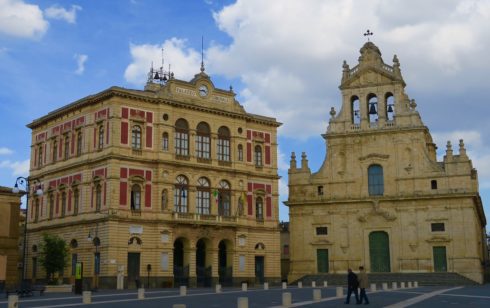
It’s been a long day and we head back to Catania with the very pleasant memory of our greeting in Pachino and the less pleasant one of the boys who died taking Grammichele. We will return to mountainous Sicily tomorrow to visit the site of an almost unbelievable tale of Canadian courage and innovation. Won’t you come along?

